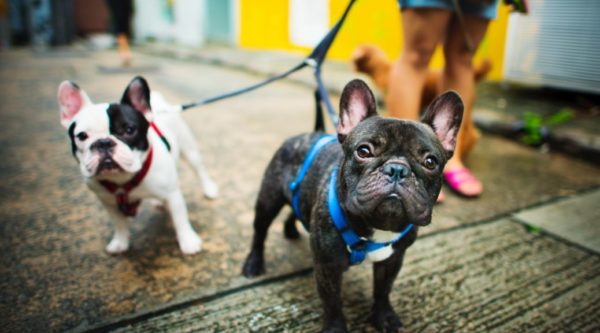Wonderful Walking Tools
by Ontario SPCA and Humane Society | Dog Care | August 15, 2018
 The wonderful (and worst) of walking tools
The wonderful (and worst) of walking tools

One of the greatest joys of dog ownership is the daily walk. Whether it’s strolling around the neighbourhood, exploring the park, or off-roading on an adventurous hike, walking is of enormous physical, mental and emotional health for your pet and you! If your dog has a penchant for pulling, however, this delightful activity can quickly become a tedious chore. To help you get a “leash” on your dog’s pulling, we’ve included a guide to the wonderful (and worst) walking tools available.
Remember, a great walking tool will help interrupt and manage your dog’s pulling, which gives you the opportunity to use positive-reinforcement (praise, treats, toys, play etc.) to train and reward appropriate behaviour. A bad walking tool encourages pulling, or uses punishment-based techniques that typically escalate if the dog doesn’t give the desired response. These methods are outdated, can be inhumane and should be avoided.
Always accessorize! Don’t let your dog leave home without a flat collar, ID tag, dog license and leash! You should be able to easily slide two fingers under your dog’s collar. If it is too loose, it will slip over his ears. Check the fit regularly!
 THE WONDERFUL Head halters
THE WONDERFUL Head halters
Head halters are based on a concept borrowed from horse halters. By controlling your dog’s head and nose, you control the body. When your dog begins to pull, the head halter causes the dog’s nose to be turned down and back toward you, which makes it physically difficult for her to continue pulling. Generally, it includes a link for attaching the leash under the chin. For many dogs, and strong pullers, head halters provide excellent control.
Tip: Head halters require a gradual and positive period of introduction – but are well worth the extra effort. Introduce it slowly by simply showing your dog the halter, treating her, than returning it to a drawer numerous times over a week or so. When your dog sees the halter, and automatically looks eagerly for her treat, she’s ready for step two. Next, put the halter on your dog for very short periods of time, feed treats the entire time to distract her, and remove it. Never take the halter off your dog when she’s pawing her face or making a fuss (otherwise you’ll train her to repeat the behaviour each time you put it on). Instead, distract your dog with a request, toys, playing etc., and then remove it. Practice having your dog wearing it for short periods (e.g. during commercials) before you take it “on the road.” Click here to learn more.
Pressure harnesses
Pressure harnesses fit like a flat body harness, but discourage pulling by tightening on the chest or under the forelegs when your dog tugs forward. The best ones have a cushion on the tightening cords. Some dogs can learn to pull wearing these, but they often interrupt pulling long enough to train better walking. This tool is most effective with medium to mild pullers. It is readily accepted by dogs and does not need a period of introduction.
Front-clip control harnesses
Front-clip control harnesses look like a regular body harness except that the leash attaches in front instead of over the shoulders. When your dog pulls, the tension in front of her chest reorients her back towards you. It works to reduce pulling immediately for many dogs and continues to work well as a management tool over time.
Limited slip collars (Martingale)
These collars are a combination of “slip” and “quick-release” collars with a two loop design. The leash is attached to the smaller loop and is engineered to tighten the larger loop when more control is needed without actually constricting around the dog’s neck. The collar uses light discomfort to discourage pulling in sensitive dogs by tightening around your dog’s neck when he pulls (without choking), and staying loose around your dog’s neck when he’s walking nicely. This is also useful for dogs that are fearful and/or can back out of a regular collar (e.g. greyhounds, because their necks are larger than their heads). It comes in two versions: one has a small nylon loop, the other has a small chain loop (the larger loop that fits around the dog’s neck is nylon).
NOT RECOMMENDED Flat harnesses
Flat harnesses fit around the chest of your dog, with the leash attachment usually at the spine. They are sometimes used for small delicate dogs instead of attaching the leash to a collar, and are often used for dogs pulling loads (sleds, carts). This tool tends to encourage pulling.
Choke chains
Choke chains are metal link slip-collars that tighten when pulled, literally choking your dog. These are sometimes used to punish unwanted behaviour in dogs in the heel position. It does NOT address leash pulling in any way and can cause injury to your dog, including serious and permanent injuries to a dog’s neck, voice box and back. Choke chains should never be used as a collar as it can cause permanent damage to your dog’s neck and throat, and it can easily get caught on something and choke your dog when he tries to escape.
Pinch/prong collars
Pinch collars are metal link collars with “prongs” or “pinchers” that distribute pressure all around the neck when tightened. These have a limited-slip chain worn at the back of the neck. It uses pain to punish pulling.
THE WORST Electric shock collars
These devices are cruel and should never be used to control a dog. Shock collars give a dog an electric shock if a dog misbehaves. Note: The alternative for training (although not typically used for walking) is a citronella spray collar that sprays a blast of non-toxic natural perfume that dogs don’t like. There are two types available, including a remote control device that is activated by the owner. The other is used to prevent a dog from barking.
Categories
Testimonial
Totally rock
All of your wonderful staff & volunteers totally rock. The amazing compassion and work you provide on a daily basis is incredible.
